2017 BMW i3 REx
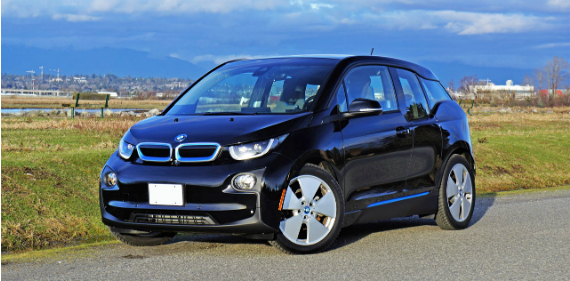
A lot more range makes for a much more utile EV
A lot has happened on the electric vehicle front since BMW came to market with its i3 in the spring of 2014. It was an anomaly among premium carmakers at the time, and while no competitive brand has anted up with a subcompact hatchback to do direct battle with this upstart imp, plenty have entered the plug-in hybrid fray.
The i3 started life with a cute albeit unusual exterior design and one of the more appealing interiors I’d experienced up to that point. Today, its outer styling remains quirky yet relatively fresh due to rarity, and its interior is still among personal favorites.
It was always a bomb to drive, with quick acceleration and superb handling, the latter surprising when first eyeing its tall, narrow, stubby proportions, and while its approximate 100 miles of electric-only range was reasonable for the day, more would’ve helped. That’s how it stayed for its first few years, but for 2017 BMW bumped up the capacity of its battery from 22.0- to 33.0-kWh, allowing for a claimed 125-mile range.
Before getting too excited you should be aware that the EPA gives it a more conservative 114-mile range rating, but either one represents a 40-percent improvement in EV-specific distance traveled between charges, which is a positive step forward. Then again, we live in an era of 240-mile Bolts and 310-mile Model 3s, both of which cost less than the i3.
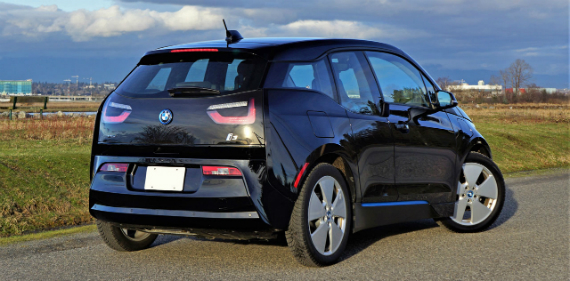
Yes, the i3 has always been a pricy little runabout. It was initially $41,350 in 2014, but its MSRP quickly rose to $43,350 in 2015, $43,395 in 2016, and $44,595 in 2017. That’s an increase of nearly eight percent over five model years, odd considering battery costs are supposed to be coming down in order to make EVs more affordable and therefore more widely accepted.
This was the first base Deka model I’d tested of the four previous examples, the first in my favorite mid-grade trim with the light brown partial leather upholstery, the second in full-load leather upholstery guise, and the most recent one also totally decked out in the same leather, which helped me appreciate what $44,595 plus $950 in freight buys you.
Ok, that’s not completely accurate. Believe it or not, BMW charges extra for non-metallic black paint. I’m not joking, the i3 will set you back an additional $550 if you want standard black—Henry Ford must be rolling over in his namesake cemetery. On the positive, after 17 years of writing hundreds of reviews per annum I’ve experienced another first. Actual metallic paints will set you back the same $550 despite there being very little composite paneled area to cover—Capparis White is the only no-cost base color.
You might also notice the lovely wood trim across the dash, which requires a move up to Mega World trim and therefore adds another $1,100 to the final price, while my tester also included a $1,100 dual-pane sunroof, plus of course its $3,850 Range Extender (REx) two-cylinder gasoline engine.
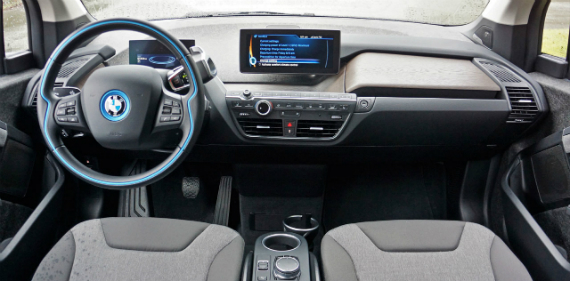
My tester also included a $2,500 Technology Assist package that added navigation with detailed mapping, advanced rear-time traffic info, semi-autonomous self-steering, and ConnectedDrive Services.
Of note, a Harmon/Kardon audio upgrade could have been had for just $300, as can Apple CarPlay for the same price (the majority of Android Auto users get no love), while $750 front parking sensors come combined with an animated graphic in the infotainment system showing the car coming close to potential front and rear fender-benders as you park, leaving $200 semi-autonomous self parking as the final option.
The Frozen Blue accents are standard, as are 19-inch alloy wheels (you can choose from others if the rims on my tester are as unappealing to you as they are to me), auto on/off LED headlights, auto-dimming interior and side mirrors (the latter also power-folding), proximity keyless access, pushbutton ignition, an electromechanical parking brake, a leather-wrapped multi-function steering wheel, cruise control, rain-sensing wipers, dual-zone auto climate control, an auxiliary heater, heatable front seats, a backup camera with active guidelines, satellite and HD radio, a universal garage door opener, rear parking sensors, emergency assist, an alarm, and more, which make it a fairly well equipped little EV.
With prospective range now somewhere between the 114-mile EPA estimate and the 124 miles projected by BMW, how did I fare? When I picked it up there was 587.9 miles on the odometer, 88 miles of estimated EV range, and an additional 51 miles of range on the REx.
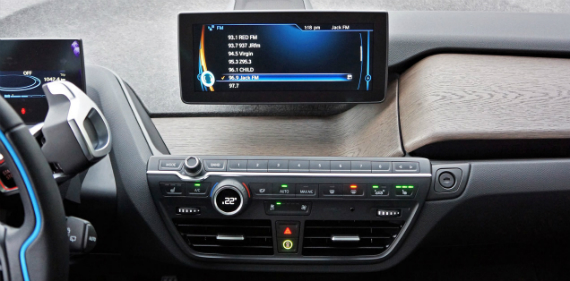
I drove 8.1 miles so that 596.0 miles showed on the odo and stopped at a local mall to get some groceries. I plugged in to charge for 46 minutes, at which point my range indicator showed 101 miles. I put on another 4.5 miles to get home leaving 600.5 miles on the odo and a range estimator showing 97 miles.
My partner joined me for the next stint, a photo shoot that normally sees her behind the camera and me behind the wheel (pivoting the car around in circles). One problem though, once we arrived at our location I realized I’d left the camera back at the house, causing me to race back and forth at a really fast clip so we didn’t lose the sun. The i3 took off from standstill like a slingshot and handled brilliantly, but if course this kind of driving isn’t the best for optimizing range. All in all our afternoon adventure totaled 18.4 miles for a new total of 618.9 miles on the odometer, plus we spent about an hour and a half “idling” while doing exterior and interior photos. All of this caused the range indicator to show 73 miles.
While this latter example hardly helps us figure out normal real-world range, we shouldn’t forget that a key consideration when purchasing an i3 is its inherent “BMW-ness,” or rather it’s quickness off the line thanks to 170 horsepower and stability through fast-paced corners due to rear-wheel drive and a wonderfully balanced suspension. For this reason its use of 25 miles of estimated range to cover 18.4 actual miles, half of which was covered at somewhat higher speeds than I’d care to mention, plus time spent going nowhere yet using up battery life, is pretty reasonable. I drove it throughout the week and found its real distance remained very true to the range indicator’s estimates, making route planning easy.
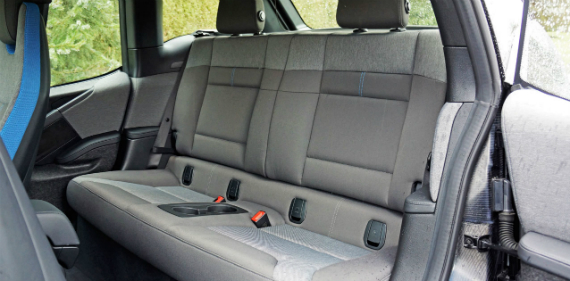
Of course, the REx takes care of any range anxiety you may have, my only real concern occurring on my last day with the car when I had too much EV range left to fully drain the battery and experience the little REx in action. Watching my clock to make sure I returned the i3 on time, I set out on the highway at about 60-65 mph in hopes that speed would quickly deplete the battery. Sure enough, with enough miles under its belt my odometer showed 675.1 miles and my range indicator displayed zilch. At 676.0 miles I felt the REx switch on, which was only noticeable due to a slight whirring from behind. The REx makes a constant, even droning noise, because it’s not actually driving the motive wheels but instead recharging the battery. Let your foot off the throttle and it winds down to a low hum, but reapply it and the constant revs resume. I certainly had no trouble keeping up in traffic on the highway, the little car still providing plenty of passing power. Truly, it didn’t feel any different than the electric motor on its own.
As for charging, the standard i3 incorporates AC quick charging and the REx upgrade adds DC quick charging as well, which means you can add an 80-percent charge to your battery in about 40 minutes. That’s if you can find a DC quick charger. I’d recommend you purchase one for your home if you live somewhere it can be installed. If you don’t, I can’t recommend a plug-in at all. A couple of years ago, using a public charger wasn’t an issue in my city because there weren’t many electrics on the road, but now there are a lot more EV drivers thanks to cars like this impressive little i3, so you’re going to be hard pressed to find one that’s not already in use.
If you can find a 240-volt public charge station that’s not already taken the i3 needs between four to five hours to completely fill up, while if you’ve got to charge it from a 120-volt socket at home you’ll need 13 to 16 hours. In other words, plug it in when you get home from work until you leave the next morning. If you’re driving an older generation i3 and these charge times seem too long, remember the 2017 model’s larger battery needs more time to top up. In comparison, the Chevy Bolt’s 60kW/h battery can take up to 36 hours to charge from a conventional home socket.
No matter which EV you’re considering, the fed offers up to $7,500 in taxpayer money to coax you into cleaning up your act, leaving regular working stiffs who can’t afford one of these pricy EVs to foot the bill so richer folk can drive a nicer car. That’s a political discussion for another time, and arguably EVs like the i3 wouldn’t exist without some governmental assistance.
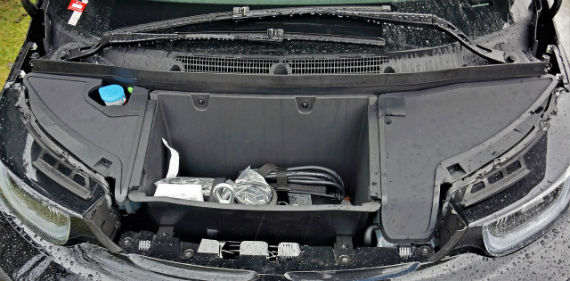
For the time being the i3 remains one of few full EVs offered under a premium badge, unless you consider Smart premium, in which case you can opt for the ForTwo Electric Drive. The Mercedes-Benz B-Class Electric Drive and the Tesla 3 are the others.
This said plenty of premium EVs are on the way, which will go a long way to promoting cleaner local air. Until then, consider the i3. It’s not the newest EV on the block, but it’s still very capable and provides a premium driving experience along with a level of interior refinement that’s unmatched thus far. Likewise, its advanced carbon-fiber monocoque construction is the stuff of supercar dreams, and just one more reason why BMW EV customers can feel like they’re getting their money’s worth when bucking up for this pricey little subcompact.
*Story credits: Trevor Hofmann, American Auto Press Photo credits: Karen Tuggay, American Auto Press Copyright: American Auto Press *
